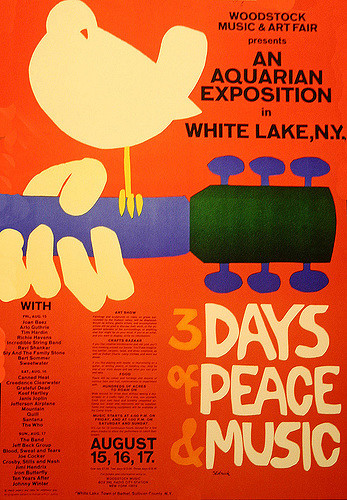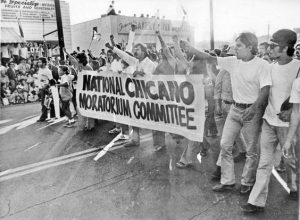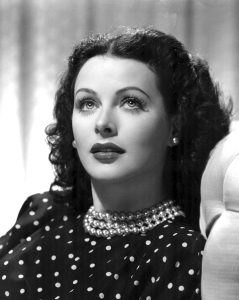The Sixties. We think of the Vietnam War, Civil Rights protests, the assassination of John F. Kennedy, the Apollo landing on the moon, hippies, Peace on Earth, and most importantly, the music. Music is how famous musicians express their thoughts and feelings to a broader audience.1 The Sixties made history through its music and more iconically, through a three-day concert known as Woodstock.

It all started with four young men that wanted to build a recording studio: John Roberts, 26-years-old, and an heir to a drugstore and a multi-million dollar trust fund; Joel Rosenman, 24-years-old, a Yale Law School graduate, and guitar player for a lounge band in Long Island and Las Vegas hotels; Artie Kornfeld, 25-years-old, a songwriter, producer, and the vice president of Capitol Records; and finally, Michael Lang, 23-years-old, and owner of a head shop that sold accessories for weed, tobacco, and other recreational drugs in Florida.2 All four men met in February of 1969 and came up with the idea of creating a rock festival, and they discussed the budget for it. They met several times after to discuss other ideas for the festival. And by their last meeting, they had a budget of five hundred thousand dollars, and were hoping for fifty thousand people to attend. Unknowingly, their “Woodstock” would become the world’s largest and most remembered Rock concert of all time.

In March of 1969, the four young men formed the Woodstock Ventures company, and each man held a twenty-five percent stake in it.3 The team now needed a location for the concert; they decided to hold the concert in a three hundred acre dairy farm in Bethel, New York, because it offered easy access from New York City, less than a mile from Route 17. And it offered electricity and water lines.4 They paid seventy five thousand dollars for the rental of the property to Max Yasgur, the owner.5 By April, Kornfeld and Lang wanted to advertise and introduce Woodstock as a place of freedom with music. They had promoters create a Woodstock image for the public. The group came up with the slogan “Three Days of Peace and Music,” because they figured, if people read “peace” in the poster, it would keep the public calm and the event free of violence. The group then hired artist Arnold Skolnick to create the image for a poster. What people thought was originally a dove on the Woodstock poster was actually a catbird, which was one of Arnold’s favorite things to draw. When Arnold finally completed the drawing for the Woodstock poster, it featured a catbird sitting on a flute along with the slogan, “Three Days of Peace and Music.” This design was approved by Woodstock Ventures. However, at the last minute, Arnold made a minor change by having the catbird stand on a guitar instead of the flute, and the poster was completed.6
Woodstock Ventures wanted the most popular rock’n’roll bands to perform at the concert. They composed contracts for each band member attending, which came with promising paychecks. They signed Jefferson Airplane for twelve thousand dollars, Creedence Clearwater Revival for eleven thousand five hundred dollars, and The Who for twelve thousand five hundred dollars.3 They had a total of thirty-two bands listed to play, including Janis Joplin, The Grateful Dead, Joe Cocker, Crosby, Stills, Nash and Young, and others. The highest paid performer was Jimi Hendrix, who signed for thirty-two thousand dollars. Hendrix would be the last act to perform and he famously closed the festival with his version of the “Star Spangled Banner,” which has gone down in history as one of the greatest performances of his career.8 Woodstock Ventures paid a total of one hundred and eighty thousand dollars for all the musicians who performed in the concert. Lang made the decision that he did not care what it would cost to get a rock band to perform for Woodstock. They would pay the deposit and create the contracts at whatever cost to ensure that they had the best performers.
By the spring time, advertisements for Woodstock started appearing in the New York Times and on radio stations across the country.9 While Woodstock Ventures had originally expected fifty thousand people to attend the festival, they sold a total of one hundred and eighty six thousand tickets, costing six dollars per day.10 In August, one week before show time, Kornfeld wanted to capture the stories of the people, their thoughts about Vietnam War, and their thoughts about Woodstock. Kornfeld made an offer with Warner Brothers to document the festival. Woodstock Ventures paid one hundred thousand dollars to have the festival filmed, and a contract was signed agreeing that if the film made it big they would get paid double the amount, and if it failed they would get nothing.
On August 14, 1969, the day before the festival, early in the morning, Woodstock Ventures noticed that traffic was backed up ten miles long on Route 17, and they were shocked to see that so many people were attending. An estimated twenty five thousand people were already waiting before the festival began.11 The four young men knew this concert was going to be amazing, but they never thought that it would go down in history as one of the biggest and “the greatest peaceful events in history,” as Time magazine called it.12

Throughout the years many attempts to recreate another Woodstock have failed. The Woodstock of 1969 will forever go down in history for its great music, the psychedelic people, and most importantly, a once in a lifetime event that can never be forgotten.
- Alan Brinkley, American History: Connecting with the Past Volume 2 (New York: McGraw-Hill Education, 2014), 812-813. ↵
- “How Woodstock Happened,” reprinted from The Times Herald-Record, 1994. http://www.edjusticeonline.com/woodstock/history/index.htm. (accessed November 17, 2016). ↵
- “How Woodstock Happened,” reprinted from The Times Herald-Record, 1994. http://www.edjusticeonline.com/woodstock/history/index.htm. (accessed November 17, 2016). ↵
- “Woodstock Music Festival.” History.com, 2009, http://www.history.com/this-day-in-history/woodstock-music-festival-concludes. (accessed November 10, 2016). ↵
- “How Woodstock Happened,” The Times Herald-Record Woodstock Commemorative Edition, 1994, http://www.edjusticeonline.com/woodstock/history/index.htm. (accessed November 17, 2016). ↵
- “How Woodstock Happened,” The Times Herald-Record Woodstock Commemorative Edition, 1994, http://www.edjusticeonline.com/woodstock/history/index.htm. (accessed November 17, 2016). ↵
- “How Woodstock Happened,” reprinted from The Times Herald-Record, 1994. http://www.edjusticeonline.com/woodstock/history/index.htm. (accessed November 17, 2016). ↵
- Spencer Bright, “Forty far-out Facts you never knew about Woodstock,” Daily Mail, August 7 2009. ↵
- “How Woodstock Happened,” The Times Herald-Record Woodstock Commemorative Edition, 1994, http://www.edjusticeonline.com/woodstock/history/index.htm. (accessed November 17, 2016). ↵
- Daily Mail, August 2009, s.v. “Forty far-out Facts you never knew about Woodstock,” by Spencer Bright. ↵
- “How Woodstock Happened,” reprinted from The Times Herald-Record, 1994. http://www.edjusticeonline.com/woodstock/history/index.htm. (accessed November 17, 2016). ↵
- Daily Mail, August 2009, s.v. “Forty far-out Facts you never knew about Woodstock,” by Spencer Bright. ↵




75 comments
Jadyn Evans
This article is amazing. I love how so much creatvity and passion went into creating such a histoic moment in music history. There are so many diffrent accounts and stories about Woodstock that make me envious to not have been there. Not only that but what Woodstock meant to the whole United States and the love and peace between people brought together by music.
Destiny Lucero
I think it would have been quite the time to be alive to experience the famous Woodstock festival of 1969. Those people got to be apart of history and got to witness huge music sensations that are still popular today, and they all just went for a good time. My favorite probably would of been the highest paid entertainer Hendrix. I think it is so silly that on the poster he drew a catbird which was mistaken as a dove.
Kennedy Arcos
This article was very informative and super interesting. I think it is amazing how the Woodstock venue was able to peacefully hold so many people. Woodstock is definitely one of the most legendary rock n roll music festivals. It also kickstarted and impacted many more music festivals after it. It is so crazy how these young men were able to pull off something so huge and Iconic. Great Article!
Samantha Zamorano
It’s fascinating that an idea brought by four people created the largest music festival that most people now about today. The article mentions how there were attempts to recreate another Woodstock concert and the attempts were unsuccessful. I wonder if Coachella could be considered modern day Woodstock? I remember one of my music teachers in middle school showed us Jimi Hendrix’s rendition of The Star Spangled Banner. One can only imagine his intentions behind ending the festival with that song—amidst the Vietnam War.
Jose Chaman
This article is simply amazing. Being a music lover, I have heard thousands of times how famous and eccentric the Woodstock festival was. However, I never knew more about the background information of the event creation. Being the end of the 60’s, this concert was really a message not only to the United States but to the whole world: peace and music are often synonymous.
Isabella Torres
This article was very interesting and informative. I’ve always been intrigued with the idea of Woodstock and music festivals in general. It definitely jump-started so many more music festivals but Woodstock will always be the most significant and legendary one; it’s so surprising that tickets were only $6. I also had no clue that it was put together the way it was and I definitely learned a lot about the meaning behind creating the festival. I really love how they strived to create a peaceful energy so that everyone was able to come together and simply enjoy the music.
Michael Lazcano
Rock and roll has always been near and dear to my heart, and to read an article such as this makes my heart swell. I had always known about Woodstock and heard that at some point in time it was one of the greatest festivals in history but I never knew of it’s humble beginnings. If someone was to start a festival today with $500,000 they wouldn’t get near as much talent as the four did back in 1969. Legends performed back in the day for couple thousand dollars to thirty thousand, while some artists today demand more. Media today is also focused more on the rap and hip hop culture which seems to promote violence and the use of drugs, while Woodstock promoted peace (even though marijuana was probably largely consumed during the festival). Any attempts to recreate Woodstock 1969 have seemed to fail, no line up can compare to that one, maybe live aid but that’s debatable. Woodstock will go down in history, and with the revitalization of rock and roll it has made it’s return, maybe 1969 will not be a thing of the past anymore.
Mia Morales
Woodstock is a very iconic festival that advocated for love and a more peaceful world. I admire how the people who created this event used music and art as a way to protest peacefully. Music is so powerful and influential and can bring thousands of people together. It would be so cool if another festival like this happened today.
Christopher Hohman
Nice article. Woodstock sounds like it must have been quite the concert and also quite fun. I like how the four men involved wanted their concert to represent peace on earth. Even though that sounds so hippie it is an admirable goal. To have over a hundred thousand attendees must have been slightly overwhelming for the owners because they had never done anything like that before. It is also cool that even though many people have tried to recreate it no one has been able to successfully.
Eric Ortega Rodriguez
I remember talking very briefly about The Woodstock of 1969 in my United States history class in high school. It truly is amazing when I read about the huge venue that these young men were able to create. I can not imagine how difficult it is to run these massive venues and even have the amazing Jimi Hendrix perform at Woodstock. I was also surprised that it is considered “the greatest peaceful events in history” by Time magazine. Overall, very original topic and very well written. Good work.